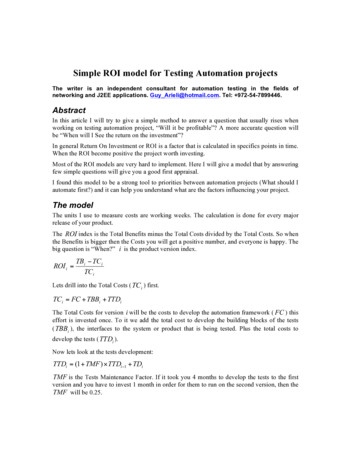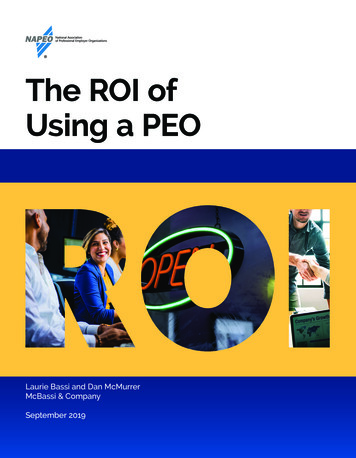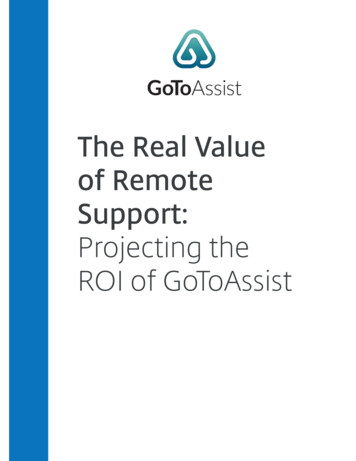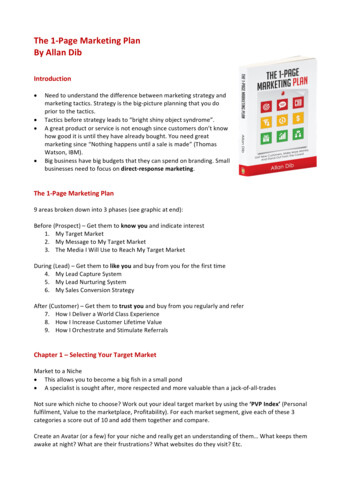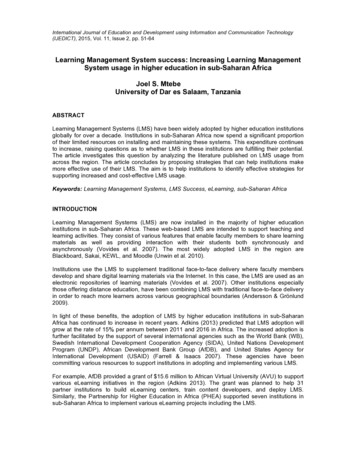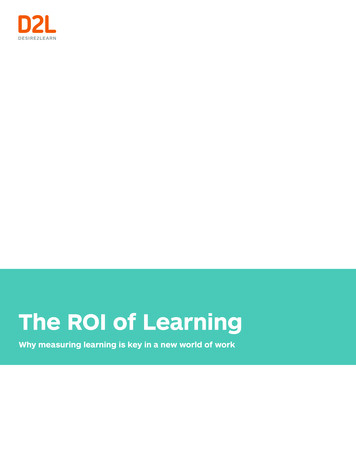
Transcription
The ROI of LearningWhy measuring learning is key in a new world of work
ABSTRACTA highly engaged workforce is not only more productive–engagedemployees are shown to drive higher levels of customer satisfaction,profit and shareholder returns.1 There is a clear link between learningculture and engagement.2 However, despite billions of dollars spentin learning and development, corporations are failing to engage theirpeople. This apathy is impacting customer satisfaction, profit, revenuegrowth at the corporate level, and is costing the US economy up to 550 billion in lost productivity each year.This paper will examine the shifting demographics and expectations ofthe workplace, looking at the impact of a new generation of millennialworkers on learning engagement, corporate learning, and developmentmethods. It will share resources to enable learning professionals to showthe value of learning by measuring the returns on their training ng-employee-engagement-statistics/Bersin by Deloitte, Becoming Irresistible: A New Model for Employee Engagement (2015)
Disengaged Employees at What Cost?A highly engaged workforce is not only moreproductive. Engaged employees are shown todrive higher levels of customer satisfaction,profit and shareholder returns.3 It is no wonderthat employee engagement is a top-of-mindissue for business leaders, eager to reap thebenefits of a fully engaged workforce to achievetheir business objectives.Employers in all sizes of organizations aremaking heavy investments in training; seekingto activate and engage workers. According toBersin by Deloitte’s 2014 Corporate LearningFactbook, US spending on corporate trainingin 2014 grew by 15% (over the previous year) to 70 billion US and 130 billion worldwide, withthe average company investing nearly 1,000per employee. In 2015, US corporations reporteda further 10% increase in training expenditureswith the highest spending devoted tomanagement and leadership.4And yet despite these significant traininginvestments, something is failing to click.A staggering 68% of employees worldwide arenot engaged (or actively disengaged) at work.5They are simply showing up and killing time,doing the bare minimum required to get theirjob done. This widespread issue of employeedetachment is costing the US economybetween 450 and 550 billion in lostproductivity gagement-stagnant-2015.aspx62015 Gallup Research, Majority of US Employees Not Engaged, Despite Gains in 201434
Training’s Failure of ReturnWith this substantial investment in training, why are westill struggling to increase engagement and prove thevalue of learning and development?Part of the challenge is the changing demographicsof the workforce and the changes in how we work. In2015, millennials (those born between 1980 and 2000)became the largest portion of the workforce.These individuals are ambitious, loyalty-lite, andhungry for development opportunities. They are alsoincredibly tech-savvy: hyper-connected, always-on,social, and mobile. They bring unique learningdemands to an organization, and fully expect thecompany to adapt learning and developmentstrategies to meet their needs.At the same time, across all demographics in theworkforce, our way of working is changing. We aremore connected, the lines between work and homeare more fluid, and innovation and change areexpected and required for businesses to thrive in themarketplace. For individuals, this means there is aneed to keep skills sharp constantly to maintainemployability. As Stephen Covey says in his bookPrimary Greatness: “Security lies in the ability tocontinue to produce what the marketplace wants, andthose wants are constantly changing. Unless peoplelearn, change, grow, and progress to accommodatethe market, there can be no security. Security lies inthe power to continually learn.”7Corporations seeking to attract and retain millennials,and meet the needs for continual learning across theworkforce, will need to shift traditional face-to-facetraining methods to integrate modern online learningplatforms capable of supporting a more dynamic,collaborative learning format while delivering contentin small, easily consumable bit-sized chunks.7Covey, Stephen R. 2015. Primary Greatness - The 12 Levers of Success. New York: Simon and Schuster.
“Employers must adjust corporate values, workplace environment, and team structures tostay competitive. Integrating corporate education into a company’s strategic goals is theway to enact these needed changes and create and maintain an agile business. By investingin corporate learning, employers have the power to address millennial retention in three keyareas: talent attraction; job readiness; and culture change.”- Jason Wingard, Dean and Professor, Columbia University’s School of Professional Studies.8Recognizing that corporate learning goeshand in hand with competitive advantage,global organizations also need to ensure learningopportunities are fully scalable across theirorganization. This means efficiently andcost-effectively providing learning in manylanguages and learning formats, in all parts ofthe world, and via 24/7 access. It’s simply notaffordable to scale traditional face-to-facetraining methods to meet the needs of a large,global, and increasingly virtual enterprise.Another part of the challenge is the abilityto analyze and track returns on learninginvestments. With greater investments inlearning, the need to track and measurelearning programs is ever-increasing–yet manycompanies struggle with return on investmentof learning. According to ATD’s recent studyon Evaluating Learning, 65% of organizationssurveyed do not measure the business resultsof their learning investments.9Learning and development professionals arewell-versed in areas such as learning objectivesand designing effective programs. When it comesto discussing hard measures in financial termsthough, some turn away and avoid this type ofanalysis as they feel ill-equipped to discuss theirprograms in financial terms. However, learningprofessionals who are unfamiliar with return oninvestment can remember that developmentapplies to their work as well–applying a growthmindset, to quote Carol Dweck, and becomingskilled in ROI is an investment in their ownknowledge and career.10Learning is a key component of the new worldof work, and sharing the value of learning isincreasingly important. We’ll review the industrystandards for evaluation and ROI, and sharesome methods to apply these to real worldprograms. This paper can serve as a start onthe journey to being able to speak with confidenceabout the impact of programs, or as a refresherto dust off ROI skills and prove the value oflearning in the ingard/want-millennials-to-stay b 9824258.htmlATD. 2016. Evaluating Learning–Getting to Measurements That Matter. Research report, Alexandria, VA: ATD Research.10https://www.ted.com/talks/carol dweck the power of believing that you can improve?language en89
Tracking LearningEffectiveness a Topic of ConcernWith corporate training investments nowreaching well into the billions, and 90% ofcompanies indicating that building capabilitiesis a top 10 priority for their organization11, it isnot surprising that measurement of trainingeffectiveness is a topic of concern for manytraining and development practitioners. Thisconcern is further magnified for organizationsthat are adopting online learning, as there aretypically higher upfront investment costs thantraining delivered in a traditional classroom-stylesetting, for instance, the purchase of a learningplatform and the adaptation of traditionalinstructor-led curriculum into interactive,dynamic online or blended content.1112When measuring learning anddevelopment effectiveness, organizationstypically want to know: Are learning programs meeting their objectives? What topics are most valuable to learners? Are they using the right delivery methods? Are learners engaged and applying thecontent in their roles? Are learning programs able to demonstratereal/tangible benefit for dollars invested, such as:Improved productivityDecreased errorsHigher customer satisfactionIncreased employee retention12Cermak, Jenny, and Monica McGurk. "Putting a Value on Training."McKinsey & Company. McKinsey & Company, July 2010. Web.Polchin, Rose. "Measuring the Effectiveness of Your Training Program."ICMI. UBM, 2 July 2014. Web.
Determining Training EffectivenessKirkpatrick’s Evaluation ModelOrganizations measuring training effectivenesscan start with Kirkpatrick’s four-level trainingevaluation model, as the de facto industry standard(see sidebar).13 It provides a robust model to examinethe impact of learning, across a variety ofquantitative and qualitative success outcomes.Developed by Dr. Donald Kirkpatrick in1954, the Kirkpatrick Model has becomethe industry standard for trainingevaluation. In 2010, Dr. Jim Kirkpatrick andWendy Kirkpatrick clarified the originalintent of the Kirkpatrick four levels withthe New World Kirkpatrick Model toincorporate greater aspects of employeeengagement.Evaluating the FinancialReturns–Phillips ROI MethodologyLevel 1: ReactionAs executives begin to question training’s valuecontribution to the company’s bottom line, and ascorporations invest in new online learning platforms tocater to the modern workforce needs, measurement ofhard cost returns becomes imperative.Dr. Jack Phillips took Kirkpatrick’s levels and added afifth level for ROI as a measurement of the businessimpact of a training program. Phillips’ methodologycovers the planning, data collection, analysis, andreporting necessary to determine ROI results.14 Phillipsmethodology is used by many training professionalsto examine the return on investment of training.The degree to which participants find thetraining favorable, engaging and relevantto their jobs.Customer SatisfactionThe original definition measured onlyparticipant satisfaction with the training.New World Additions:EngagementThe degree to which participants areactively involved in and contributing tothe learning experience.RelevanceThe degree to which training participantswill have the opportunity to use or applywhat they learned in training on the job. Sidebar continued on next tute/
ROI FormulaLevel 2: LearningThe calculation for ROI involves converting theimpact data from level 4 to monetary values,determining the fully loaded costs of the learningprogram, and calculating the return on investmentusing the formula below:16The degree to which participantsacquire the intended knowledge, skills,attitude, confidence, and commitmentbased on their participation in thetraining.Knowledge: “I know it.”Skill: “I can do it right now.”Attitude: “I believe this will beworthwhile to do on the job.”New World Additions:Confidence: “I think I can do it on the job.”Commitment: “I intend to do it on the job.”A result greater than 0% means that a training programhas a net benefit after accounting for the costsinvolved in running it. For instance, an ROI% 50%means that the training program yielded a 50% returnon money invested or that for every one dollar theprogram cost, the company yielded 1.50. A resultless than 0% means the program had a net cost. Thismeans that the training program did not recoup itscost after accounting for the benefit. Often,practitioners will forego the percentage result andshare the return in dollars alone, for example with anROI of 50% for a program that cost 10,000, they wouldshare that the return was 15,000 to the organization,or 1.50 for every dollar invested.There are a variety of approaches available tomeasure learning and development program ROI,and a wealth of resources available detailingevaluation and business impact measures. Theoptimum approach varies based on the program,organization and practitioner. Training practitionersneed to identify the model that works best for theirorganization and unique circumstances. In thefollowing sections we offer two methods that canwork well in many organizations.Level 3: BehaviorThe degree to which participants applywhat they learned during training whenthey are back on the job.New World Addition:Required DriversProcesses and systems that reinforce,encourage and reward performance ofcritical behaviors on the job.Level 4: ResultsThe degree to which targeted outcomesoccur as a result of the training and thesupport and accountability package.New World Addition:Leading IndicatorsShort-term observations andmeasurements suggesting that criticalbehaviors are on track to create apositive impact on desired ault.aspxT. Elkeles, P. Phillps and J. Phillips. 2014. Measuring the Success of Learning Through Technology: A Guide for Measuring Impact and Calculating the ROI onE-Learning, Blended Learning and Mobile Learning. ATD.1516
Data Measures: Use AvailableEngagement and Productivity DataWith data and analytics ubiquitous in theworkplace today, there are often measures inplace that training practitioners can integrateinto their evaluation methods. In cases wherethe engagement or productivity of the traineesis already measured regularly in systems,training participants’ stats before and aftertraining can be compared to evaluate trainingresults. Post-training measurement needs toallow time for participants to apply new skills andchange their work behaviours. Three months isa generally accepted length of time for traineesto integrate new skills to their work so it is oftenused as an appropriate timeframe for measuringproductivity post training.When using engagement or productivitydata, other factors beyond skills changefrom training can affect the productivity andengagement measures. For this reason,it is important to integrate a method to isolatethe effects of training as much as possible.Practitioners can consider using interviewsor surveys to isolate the effects of training. Byasking participants or their managers what otherfactors influenced the change in productivityand / or what percentage of the productivityimprovement they would attribute to training,practitioners can narrow down the results ofthe improvement associated with training.
Expectation Measures: CalculateReturn on ExpectationWhen productivity measures are not readily availablefor the learning participants, return on expectationcan be an alternate method. Return on expectationconsists of gathering data before training regardingmanagers or participants’ expectations of thetraining out comes, and then gathering data afterthe training to determine the degree to which thetraining met the expectations. The choice ofwhich stakeholders to use for gathering return onexpectation should be determined by which group isin the best position to speak to results observed posttraining. Often, this is the manager or participants oftraining. Questions should be included to accountfor the managers’/participants level of confidence inreporting the results observed, and as mentionedwith productivity measures, the percentage ofimprovement they would attribute to training.The practitioner can interview managers before thetraining to find out what they expect for the trainingoutcome. This data can be used in the design ofthe program to ensure the training is aligned withbusiness objectives. Three months after the trainingis completed, the same interviewees can be contactedto find out what results the managers/participants areseeing as a result of the training, and if those resultsmet their expectations. The results identified can betranslated to a dollar figure and included for acalculation of ROI.Typical “expectations” that convert into successoutcomes include: Revenue from new customers Increased operational efficiencieswith decreased training costs Reduced turnaround times Increased retention of top talent1717Kirkpatrick, Jim. "Return on Expectations: The Ultimate Demonstration of Training Value." Web log post. Coaching. TrainingZone, 25 Aug. 2009. Web.
Putting ROI Calculations into PracticeThere are a number of options to choose from when seeking to calculate the ROI from anorganization’s training investments, and the method used can vary with the particularprogram and its unique characteristics.Some key questions and considerations before you begin: Does your organization have systems in place, such as a corporate HCM or LMS, for administering trainingand for gathering training-related data? Can this data be mined and analyzed to feed an ROI calculation? What exactly are your executives looking for when they request an ROI study? Have you consulted executivesponsors to fully understand (and manage) their expectations? Is self-reported data (i.e. information gathered through interviews and surveys) already in use in the companyand an accepted part of the culture? If you plan to compare groups who received training against those who did not, will it be possible toestablish a control group for accurate analysis?
The Business Case for LearningAs the millennials form the majority of the workforce, and aslearning and development activities move online to scale learningacross the global organization, engaging learning deliveredthrough an online platform can help to meet the needs of alltypes of learners. To implement such a strategy however, trainingpractitioners will need to provide a solid business case toleadership to offset the associated investment. They will need toemploy proven return on investment analyses to clearly show thatthe increased level of engagement realized within the workforceeasily offsets the costs associated with the organization’sinvestment in learning.Beginning an ROI analysis can be a daunting task for atraining practitioner unaccustomed to performing one. However,by embracing a growth mindset, using the right calculation method,and by clearly understanding stakeholders’ goals, practitionerswill have the tools to articulate the value of the learning anddevelopment investment in terms executives understand. Thiswill enable definitive proof that demonstrates the organization’ssubstantial investments in training not only makes employees feelengaged, valued and appreciated; they also translate into real,tangible business returns.
About D2LD2L is the software leader that makes learning experiencesbetter. The company’s cloud-based platform, Brightspace,is easy to use, flexible, and smart. With Brightspace,organizations can personalize the experience for everylearner to deliver real results. The company is a worldleader in learning analytics: its platform predicts learnerperformance so that organizations can take action in real-timeto keep learners on track. Brightspace is used by learners inhigher education, K-12, and the enterprise sector, including theFortune 1000. D2L has operations in the United States, Canada,Europe, Australia, Brazil, and Singapore.CONTACT USPhone:Toll Free:1-519-772-0325 (Worldwide)1-888-772-0325 (North America)0-808-234-4235 (United Kingdom and Europe)0-800-452-069 (New Zealand)1-800-656-210 (Australia)0-800-891-4507 r:@D2LWeb:www.D2L.com 2016 D2L Corporation.The D2L family of companies includes D2L Corporation, D2L Ltd, D2L Australia PtyLtd, D2L Europe Ltd, D2L Asia Pte Ltd, and D2L Brasil Soluções de Tecnologia para Educação Ltda.All D2L marks are trademarks of D2L Corporation. Please visit D2L.com/trademarks for a list of D2L marks.
70 billion US and 130 billion worldwide, with the average company investing nearly 1,000 per employee. In 2015, US corporations reported a further 10% increase in training expenditures with the highest spending devoted to management and leadership. And yet despite these signiicant trai




